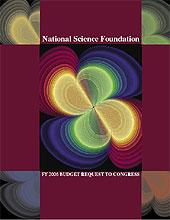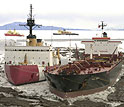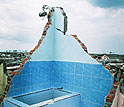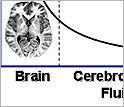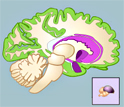News Release 05-014
NSF Submits Its Fiscal 2006 Budget Request of $5.6 Billion
Even in a tight budget climate, director sees opportunities to enable scientific growth
February 7, 2005
This material is available primarily for archival purposes. Telephone numbers or other contact information may be out of date; please see current contact information at media contacts.
ARLINGTON, Va.—National Science Foundation (NSF) Director Arden L. Bement Jr. today revealed highlights of NSF's fiscal 2006 budget request of $5.6 billion to Congressional leaders and to a public gathering at NSF. Describing the budget climate for the coming year as "constrained," Bement also viewed challenges of the 2006 request as potential opportunities to "leverage resources to enable science and engineering in key areas with sustained funding to meet national needs while working more productively."
NSF's 2006 budget request represents about a 2.4 percent increase over its 2005 budget of $5.47 billion.
"Even in this environment, there is recognition that NSF's record of providing the fuel for the American economy through discovery and innovation, which translates into economic growth, has kept us in a strong position," Bement said. "Despite some tough choices ahead, we will be able to focus energies into research that seeks the frontier and beyond, and on first-class tools and infrastructure that will help scientists and engineers be more productive."
In describing his other priorities for the new budget, Bement said NSF will provide significant support toward broadening participation in the science and engineering workforce, underscoring the need to bring about more opportunities for students to become part of the research process in first-class facilities.
Bement also noted that NSF will work to sustain and even enhance the agency's recognized excellence in management practices.
The fiscal 2006 budget includes priorities in several key areas:
- A nearly 3 percent increase in research and related activities (about $113 million above 2005) to a total of $4.3 billion. If approved by Congress, this would be the largest amount ever for NSF's support of research. The request focuses heightened attention on core research areas and includes a transfer of $48 million from the U.S. Coast Guard to NSF for operations and maintenance of icebreakers used to support scientific research in the polar regions.
- A 44 percent increase in major research equipment and facilities will fund the continued work on the Atacama Large Millimeter Array (ALMA) radio telescope; Earthscope, a multi-purpose instrument to study and predict a variety of geophysical events; IceCube, the world’s first high-energy neutrino observatory at the South Pole; the Rare Symmetry Violating Processes (RSVP) cutting-edge physics project to study fundamental properties of matter; and the Scientific Ocean Drilling Vessel (SODV) to support the long-term efforts of the international ocean drilling program.
- With significant investment reductions in NSF education programs as a whole, the agency will hold the line on key investments for programs to broaden participation in science and engineering workforce and career enhancement programs, amounting to about $400 million across NSF's portfolio. The Human Resources Division within the Directorate of Education and Human Resources will maintain investments of more than $118 million.
- NSF also requests almost $336 million for organizational excellence, about 16 percent over the 2005 budgeted amount, to further integrate sound business practices into NSF's already productive investments. An added 25 full-time staff positions are being requested to help carry out further improvements and efficiencies.
NSF will also invest $509 million in cyberinfrastructure. Considered key to improving the productivity of science, Bement says this funding for such things as modeling, simulation, visualization and data storage, among other communications breakthroughs, will contribute to transformative research that will address grand challenges in science and advance current fields more quickly, while creating new ones. "The inter-disciplines of today are becoming the disciplines of tomorrow," Bement adds.
Bement said NSF will also invest more into the social and behavioral sciences, such as in the human and social dynamics program, in recognition of their impact on other sciences and society at large.
Bement stressed that currently about $2 billion in excellent research gets tabled each year because of funding constraints. Nonetheless, NSF is always quick to respond to national needs, such as rapid deployment of the tsunami teams to the Indian Ocean to conduct reconnaissance surveys in the aftermath of the catastrophic event. Post-Sept. 11, 2001, results also indicate that NSF-supported science can make a major difference over the short-term when the nation needs to respond to such an event.
Bement said he wants to improve funding rates for NSF proposals, which has fallen from 30-33 percent to near 20 percent agency wide. He adds that improved management, a re-evaluation of the balance in the NSF portfolio between solicited and unsolicited proposals, and between individual researchers, teams and centers will be some of the elements NSF will review to lead it toward better success rates and more productivity for the science and engineering community.
Beyond discussing the budget priorities, Bement was heartened by NSF’s wide reach into many communities.
"If you look at the news daily, you see extraordinary things coming from dozens of NSF programs and initiatives that are enriching the entire science and engineering enterprise, and making education fun, exciting and achievement-oriented. Just last week, two of the most widely read and emailed stories in the nation were the discoveries of NSF-supported researchers. In one, scientists using new bio-barcode technology detected trace amounts of a protein that recent studies have linked to Alzheimer's disease. It's the first test to conclusively identify the disease in samples from living patients. It holds hope for a future tool to diagnose Alzheimer's at an early stage. In the second development, a group of scientists has proposed an entirely new brain classification system for birds, because recent studies have shown that birds are much closer in cognitive ability to mammals than previously known. The new terminology will benefit thousands of scientists, and help merge the research efforts for birds and mammals.
"These examples show that NSF, often by combining the resources of separate offices, programs and agencies, fuels the ideas leading to discoveries and broadens opportunities for people at many levels. In doing so, NSF reaches deeply into the fabric of our society to meet national needs."
-NSF-
-
The fuel tanker USNS Paul Buck (right) alongside the Coast Guard's Polar Star at McMurdo Station.
Credit and Larger Version -
The bathroom of a brick home in Sumatra partially survived the tsunami.
Credit and Larger Version -
The bio-bar-code amplification technology, which is a million times more sensitive than ...
Credit and Larger Version -
The above illustrations compare the traditional view of the primitive avian brain......
Credit and Larger Version
Program Contacts
Thomas N. Cooley, NSF, (703) 292-8200, email: tcooley@nsf.gov
Related Websites
NSF fiscal 2006 budget documents: http://www.nsf.gov/about/budget/fy2006
The U.S. National Science Foundation propels the nation forward by advancing fundamental research in all fields of science and engineering. NSF supports research and people by providing facilities, instruments and funding to support their ingenuity and sustain the U.S. as a global leader in research and innovation. With a fiscal year 2023 budget of $9.5 billion, NSF funds reach all 50 states through grants to nearly 2,000 colleges, universities and institutions. Each year, NSF receives more than 40,000 competitive proposals and makes about 11,000 new awards. Those awards include support for cooperative research with industry, Arctic and Antarctic research and operations, and U.S. participation in international scientific efforts.
Connect with us online
NSF website: nsf.gov
NSF News: nsf.gov/news
For News Media: nsf.gov/news/newsroom
Statistics: nsf.gov/statistics/
Awards database: nsf.gov/awardsearch/
Follow us on social
Twitter: twitter.com/NSF
Facebook: facebook.com/US.NSF
Instagram: instagram.com/nsfgov

